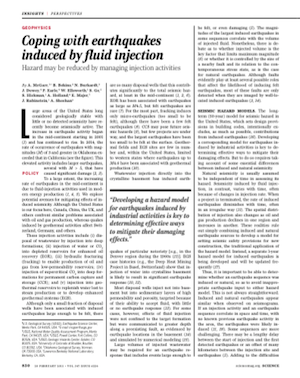
"Coping with earthquakes induced by fluid injection," was published Feb. 20, 2014 in the journal Science.


"Coping with earthquakes induced by fluid injection," was published Feb. 20, 2014 in the journal Science.

"Coping with earthquakes induced by fluid injection," was published Feb. 20, 2014 in the journal Science.
A new peer-reviewed paper published in the journal Science urges greater partnership between industry, government agencies and researchers in responding to the consequences of earthquakes triggered by oil and gas activity.
The paper, authored by the U.S. Geological Survey and other federal scientists, as well as state seismologists, including the Oklahoma Geological Survey’s Austin Holland, also endorsed more transparency:
For purposes of transparency and avoiding public distrust, it is important to put the results of these seismic network operations into the public domain in near real time. Even if a network is owned and operated by industry, regulators must ensure that seismic data are not withheld from the public.
and more public involvement:
The general public is the most important stakeholder because they may be exposed to potential injury and damage.
In a statement released with the paper’s publication, the USGS concluded that, while data collection and research should continue, there was enough scientific evidence to start “mitigating the effects” of earthquakes caused by wastewater wells used by the oil and gas industry.
“The science of induced earthquakes is ready for application, and a main goal of our study was to motivate more cooperation among the stakeholders — including the energy resources industry, government agencies, the earth science community, and the public at large — for the common purpose of reducing the consequences of earthquakes induced by fluid injection,” co-author and USGS geophysicist Bill Ellsworth wrote.
In the paper, the authors acknowledge the difficulty regulating disposal wells, a key component of oil and gas production, which is one of the state’s largest economic drivers:
The possibility of reducing the hazard of induced earthquakes has policy implications inasmuch as stakeholders are in a position to balance economic benefits of energy production activities against costs incurred owing to the increase in hazard. This cost-benefit analysis is rarely straight- forward because benefits, mostly economic, are geographically diffuse, whereas hazardous effects are localized to the environs of the injection wells. Moreover, if an induced earthquake sequence results in damage, then blame can be assigned with legal implications for liability.
The Feb. 20 paper is one of more than a half-dozen peer-reviewed articles that have linked Oklahoma’s earthquake surge to disposal wells and so-called “induced seismicity.”